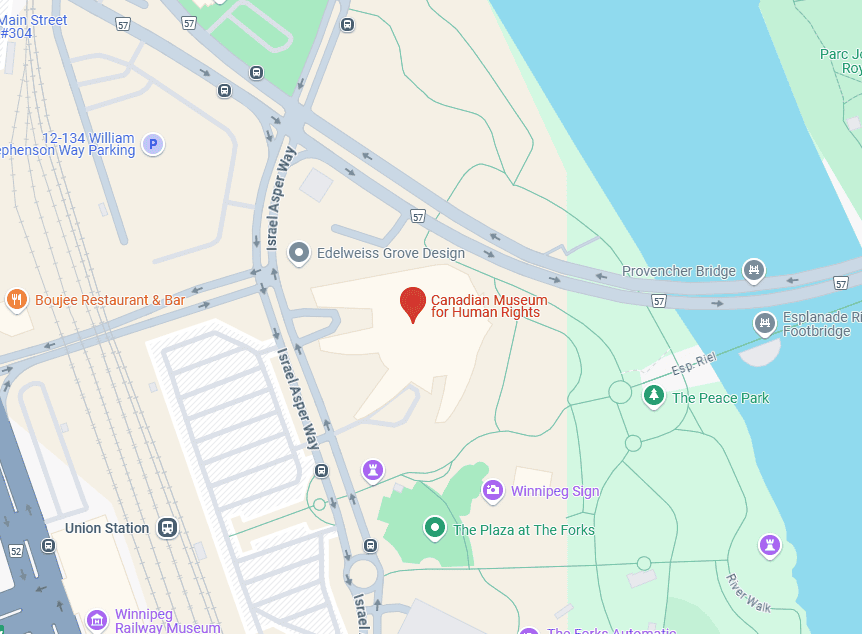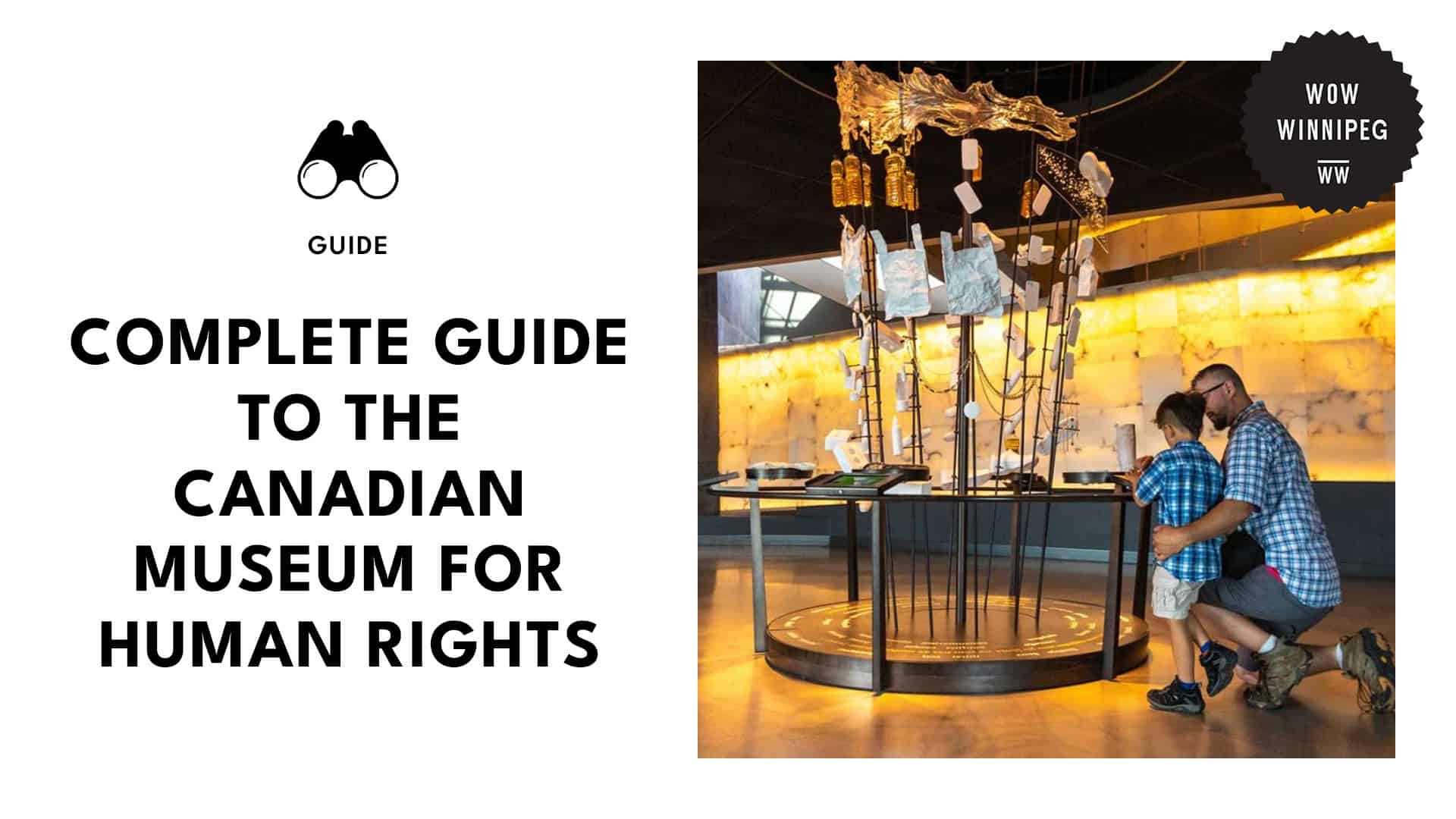Guide to the Canadian Museum for Human Rights Packed with Local Insider Tips
When my friend invited me to go to the Canadian Museum for Human Rights more than a decade ago, I almost said no. Honestly, to my younger self, it sounded kind of boring.
But I’m so glad I went because wow! What I thought would be just another museum visit turned out to be one of the most powerful and eye-opening experiences I’ve ever had.
From the museum’s uniquely shaped glass walls to its thought-provoking exhibits, you’ll definitely understand what makes this museum special to Winnipeggers.
So, if you’re planning a visit, here is my complete guide to exploring the Canadian Museum for Human Rights. I’ve included local tips and can’t-miss exhibits that stuck with me long after I walked out—enjoy!
Where is the Canadian Museum for Human Rights?

The Canadian Museum for Human Rights is located at 85 Israel Asper Way in the heart of downtown Winnipeg. It sits right by The Forks, on Indigenous ancestral lands within Treaty One Territory.
How to Get to the Canadian Museum for Human Rights
By Bus:
Winnipeg Transit has 33 routes that service the area around the museum and The Forks. It has stops located on Main Street (right outside Union Station), William Stephenson Way, and Israel Asper Way.
Bus lines like 38, 43, 44, 47, 50, 54, and 66 will all get you close.
By Car:
If you’re driving from downtown Winnipeg, start by heading north on Fort Street toward Portage Avenue. Turn right onto Portage (just keep in mind, no right turns here on weekdays between 3:30 PM and 5:30 PM).
Then, use the right lane to turn onto Westbrook Street, followed by a left onto Water Avenue (also known as William Stephenson Way). Turn right onto Israel Asper Way, then make a left and a slight left again—your destination will be on the left.
By Bike:
Start by heading south toward Fort Street, then turn left onto Fort; walk your bike briefly, then turn left onto Graham Avenue. Take a right, then a left onto York Avenue, and a right onto Israel Asper Way—one final left, and you’ll see the museum on your left.
On Foot:
From downtown Winnipeg, head south toward Fort Street, turn left onto Fort, then make another left. Take a right, then turn left onto York Avenue, a right onto Israel Asper Way, and finally, a left, which takes you to the museum.
Best Time to Visit the Canadian Museum for Human Rights
– Media credit: humanrights.ca
The best time to visit the Canadian Museum for Human Rights is on free admission days like the first Sunday of each month, Canada Day, etc. On regular days, weekday mornings and early afternoons have fewer crowds.
Things to Know about the Canadian Museum for Human Rights
– Media credit: humanrights.ca
History
The idea for the museum came from Israel Asper in 2003, and with the help of his family and others, it became a reality. One big goal is to teach people about human rights, including bringing over 20,000 students each year to learn and explore.
Winnipeg was chosen because it has an important history of standing up for people’s rights, like during the 1919 General Strike. It’s also one of Canada’s most diverse cities, home to Indigenous Peoples, French speakers, and many newcomers.
Hours of Operation
The Canadian Museum for Human Rights’ regular hours of operation are Tuesdays to Sundays, from 10 AM to 5 PM.
Check out the table below for their hours during holidays:
| Holiday | Hours |
| Canada Day (July 1) | Tue – Sun: 10 AM – 5 PM |
| National Day for Truth and Reconciliation (Sep 30) | Tue – Sun: 10 AM – 5 PM |
| Remembrance Day (Nov 11) | Tue – Sun: 10 AM – 5 PM |
| Human Rights Day (Dec 10) | Tue – Sun: 10 AM – 5 PM |
| Christmas Eve | Closed |
| Christmas Day | Closed |
| New Year’s Eve | Closed |
Admission Rates
| Visitor | Rates |
| Adults (18 to 64) | $22 |
| Youth (7 to 17) | $10 |
| Post-Secondary Student (With ID) | $17 |
| Senior (65+ With ID) | $17 |
| Family Groups (Up to 2 Adults and 4 Youth) | $54 |
| Kids (6 and Under) | Free |
| Member | Free |
| Indigenous Peoples | Free |
| Canada Day (July 1) | Free |
| National Day for Truth and Reconciliation (Sep 30) | Free |
| Remembrance Day (Nov 11) | Free |
| Human Rights Day (Dec 10) | Free |
Parking
You’ll find paid parking near the museum on Israel Asper Way, William Stephenson Way, and Waterfront Drive, along with nearby surface lots and parkades. Just a heads up—there’s no free or dedicated CMHR parking.
Accessibility
CMHR is designed to be fully accessible, with barrier-free entrances, ramps, elevators to all levels, and accessible parking and drop-off areas. Gender-inclusive and accessible washrooms are available, including adult-sized change tables and lifts.
Mobility aids like scooters, wheelchairs, and strollers are available on request, and support persons receive free admission. Visitors can also borrow cane-seats, use TTY phones, and access the Aira app for live visual guidance.
Phone Use and Photography
Feel free to take pics in the galleries and share them on social media. You can also use your phone with CMHR’s app—just keep it silent. For any special photography or media project, reach out to their Communications team.
For safety, don’t lean over railings while taking photos, and please avoid using flash or making phone calls. Bulky camera gear isn’t allowed, and photos taken in the museum can’t be used for commercial purposes.
CMHR Mobile App
CMHR offers a free mobile app that lets you take a self-guided, accessible tour using your own device or a borrowed iPod. You can download the app onsite using free WiFi or ahead of time—it’s available in English, French, ASL, and LSQ.
The app also includes audio guides narrated by museum staff, text transcripts, videos, and images. With “Near Me” mode and an interactive map, it’s easy to explore the exhibits—helpful for visitors who are blind, have low vision, or use sign language.
What to Do in the Canadian Museum for Human Rights
Check out CMHR’s core galleries
The museum’s 10 permanent galleries share powerful human rights from Canada and around the world through hands-on exhibits, videos, and creative displays. They are:
What Are Human Rights?
– Media credit: peeku.pov
Let’s face it, not everyone knows what human rights actually mean. The gallery will help you understand the concept, as well as show how it has grown over thousands of years.
Plus, you’ll see a timeline of 100 key moments around the world and hear people share their thoughts on what human rights mean to them via a multimedia show.
Indigenous Perspectives
– Media credit: humanrights.ca
If you want to understand how Indigenous Peoples think, this area’s for you. It shares the Indigenous views on rights and responsibilities, showing how everything is connected in First Nations, Metis, and Inuit worldviews.
In a circular theatre with artwork (which is pretty futuristic, like something from a sci-fi flick), visitors can watch a 360-degree film about Indigenous rights.
Canadian Journeys
– Media credit: humanrights.ca
The rights that we enjoy today are not free—it was fiercely fought over by our ancestors. This space, which is actually CMHR’s largest gallery, reminds us of their struggles.
It shares many Canadian stories about the fight for equal rights, like the right to vote, speak your language, and live free from discrimination. Their amazing stories are shown on a 29-metre screen and in smaller stations.
Protecting Rights in Canada
– Media credit: humanrights.ca
You know what’s cool? Our laws have come a long way, changing and evolving to protect human rights.
This space shows the major wins we have managed to secure, reflected in Canada’s legal system (also called a “living tree” because it can grow and adapt).
It features an actual digital tree that shows how laws change, plus a round table that lets visitors learn about key court cases.
Examining the Holocaust
– Media credit: humanrights.ca
Everyone knows that the Nazi government used old laws and violence to take away people’s rights. This display looks at the Holocaust in its entirety to help us understand and prevent genocide.
It also has a “broken glass” theatre that explores Canada’s history with anti-Semitism. I think this is one of the most eye-opening galleries for me.
Turning Points for Humanity
– Media credit: humanrights.ca
The idea that everyone has rights just for being human was shared worldwide in 1948 through the Universal Declaration of Human Rights. I mean, who knew that something we take for granted now actually had to be declared?!
There are large, digital book-shaped screens here that show how groups have fought for and gained new human rights protections.
Breaking the Silence
– Media credit: humanrights.ca
This important space looks at how silence and denial have played a role in tragedies around the world. I’ve felt so many emotions here, so I recommend taking your time to pore over each display.
It focuses on horrible events like the Holodomor, the Armenian Genocide, the Holocaust, the Rwandan Genocide, and the Srebrenica Genocide.
Actions Count
– Media credit: canmushistory
Art can say what words sometimes can’t. This area shows the Witness Blanket, a large artwork that honors children taken to residential schools in Canada—it’s made from over 800 items gathered from school sites, government buildings, churches, and more.
The idea that these Indigenous children were taken from their families and communities is really heart-wrenching. I’m just glad CMHR has a space to recognize that.
Rights Today
– Media credit: humanrights.ca
Human rights keep changing in our connected world, and I like how this exhibit underlines those changes.
This corner shows today’s human rights challenges through an interactive wall map, a display of human rights defenders, and a small theater that encourages us to think about what we see and hear.
Inspiring Change
– Media credit: humanrights.ca
What do human rights mean to you—respect, freedom, or equality?
This space is pretty cool since it draws you into the human rights conversation, inviting you to think about how you can help make the world better. To help inspire you, it also shows real events that promoted human rights.
Discover CMHR’s travelling exhibitions
– Media credit: humanrights.ca
Aside from CMHR’s core galleries, you can also explore its amazing travelling exhibitions, created by awesome local and international artists.
These cover a wide range of human rights themes and are designed for different spaces and audiences. Feel free to check out the current lineup anytime, and since these galleries are not permanent, make sure to book tickets right away.
Join one of CMHR’s guided tours
– Media credit: qtlao
If you don’t really want to wander aimlessly from one space to another, I recommend signing up for one of CMHR’s guided tours. Here, you can explore the powerful human rights stories from Canada and around the world in a more organized fashion.
A friendly guide will lead you through select galleries, sharing insights and sparking thoughtful conversation. It’s kind of like being on a field trip, but there are no teachers around, shushing you to death.
Where to Eat in the Canadian Museum for Human Rights
Bistro Boreal
– Media credit: bistro.boreal
Website: https://wowcatering.ca/BB_MENU_OCTOBER.pdf
Instagram: https://www.instagram.com/bistro.boreal/
Address: 85 Israel Asper Way
Hours: Tue – Fri: 11 AM – 4 PM
Sunday: 10 AM – 4 PM
Contact: (204) 289-2187
Located on Level 1 of CMHR, Bistro Boreal is a perfect stop for a quick bite or a relaxing lunch. Don’t miss their Grilled Southwestern Chicken Club—stacked with basil pesto aioli, ample bacon, avocado, and charred tomato salsa.
Where to Stay near the Canadian Museum for Human Rights
The Inn at the Forks
– Media credit: innattheforks
Website: https://www.innforks.com/
Instagram: https://www.instagram.com/innattheforks/
Address: 75 Forks Market Rd
Hours: Check-in time: 3:00 PM
Check-out time: 11:00 AM
Contact: (204) 942-6555
Just a 6-minute walk away from the CMHR, this hotel is the perfect place to stay in the heart of the action. Book their Culture Package to enjoy a stylish overnight stay, parking, CMHR passes, and a $35 credit for SMITH Restaurant.
If you’re looking to visit other museums or galleries in the city, you can check out our complete guides to the Manitoba Museum and WAG-Qaumajuq.


